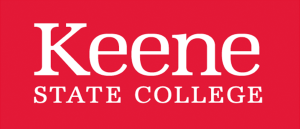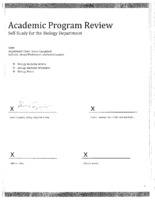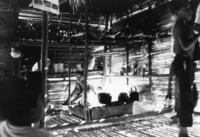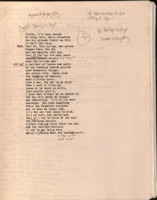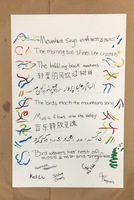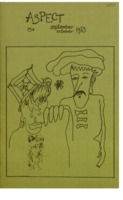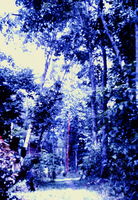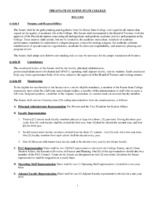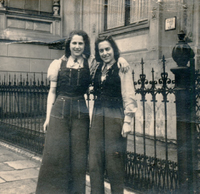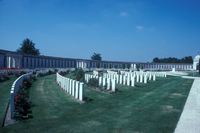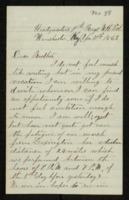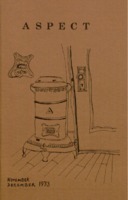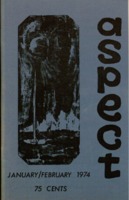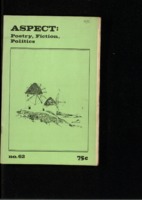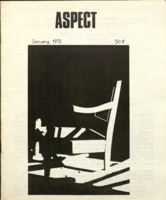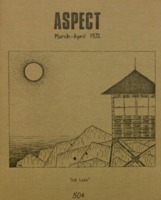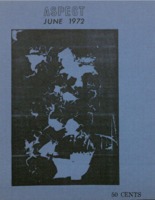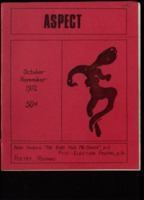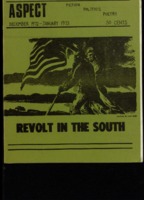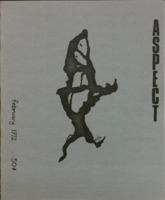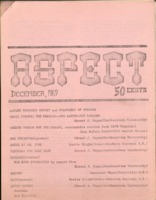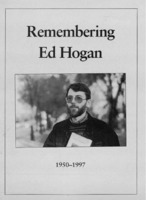Aspect Magazine
Item set
- Title
- Aspect Magazine
Items
86 item sets
-
Charles W. Wilcox Papers
The Charles Wilcox Papers belong to the Keene, New Hampshire resident who was a Union soldier during the Civil War and was captured and imprisoned in Confederate internment camps as well as prisons from 1864-1865. These papers include Wilcox’s diary, correspondence, and official documents. The papers are part of the archival holdings of the Historical Society of Cheshire County in Keene, New Hampshire, and were included as part of the NH Citizens Archivists' Initiative.
18 items
-
Aspect Magazine vol. 1, issue 4, June 1969
The cover of this issue of Aspect magazine is light blue with Aspect written in a block letter font. The cover page of this typed and stapled issue of the journal includes the table of contents for the eleven-page magazine.The issue begins with an editorial by Edward J. Hogan, = "Violence: The Necessary Tool" and is followed with three poems: "For Elize," by John Manifold, "The Crowd," by Noelle Wright, and "Limerick," by Edward J. Hogan. "Desire Under the Elms: An Unconscious Autobiography" is a summary and review by Mary Harrington of Eugene O'Neill's 1924 play. The summary is taken from the esay by Matthew T. Conlin, "The Tragic Effect of Autumn Fire and Desire Under the Elms" published in Modern Drama (February 1959).There are three additional poems : "Almost There" by Noelle Wright, "A Tree Did Grow" by Alice Nims, and "The Pope Cried, No" by Steve Kellogg , and "Seasons" by Noelle Wright.The issue includes the sixth part of Edward J. Hogan's "History Series" under the title "Edward Burke and English conservatism." On the final page there is a poem by Edward J. Hogan, "The Terrible Two," inspired by "Cream's song 'pressed Rat and Warthog' and a real-life 'terrible (ho, ho) two" as explained in a parenthetical headnote to the poem. The issue concludes with a "P.S." from the editor that reads "My Mistake! I neglected to finish the footnotes for Mary Harrington's drama article. They follow here:" -
Aspect Magazine vol. 10, issue 52, September-October 1973
The front cover of the September-October 1973 issue of Aspect magazine has a green background with a drawing of a well-dressed man and woman, drawn in stencil, surrounded by a border. The artwork is modern and contemporary. The table of contents includes a list of authors of short stories, poems, and artwork. A summary of Aspect magazine and its purpose is at the bottom, and continues onto the back cover with the credo; "If you have done it, and you like it, send it to ASPECT." Aspect welcomes articles, short stories, poetry, review, drama, cartoon, humor, photographs, and letters.The next set of pages is a sequence of short poems "Paradise" by Eric Felderman, an untitled, three-line poem by Arthur Winfield Knight, "From My 7th Floor Window Of The Mental Ward" and "The Carefree" by Fritz Hamilton, "Disturbed Professor Takes Pound Not Pills" by James Klein, and a poem in landscape format called "Uncle's Retirement" by Jane Creighton.The next section is a short story titled "The Machine Shop" by Ottone Riccio with illustrations (one of a woman angel playing a hand saw in place of a violin) and more short poems such as "the present" and "momma: but grace with grace" by R.D. Swets and another short story about Watergate and Vietnam. After the second short story there is another contemporary stencil drawing depicting three human figures and cat.Proceeding this is a final collection of abstract poems. The magazine ends with a commentary by the editor Edward J. Hogan on the contributors to the issue, a poem by Charles Bukowski, and notes about the publishing committee and "The People Inside"describing the authors -
Aspect Magazine vol. 10, issue 52, September-October, 1973
This issue includes art work, a combination of prose and verse poetry, a short story and a political essay. It was put together by co-editors Edward J. Hogan, Ellen Schwartz and Gail Braatelien. The opening contents page lists the artists by page number and some information about the issue and magazine itself. The art in this issue ranges from political commentary to more experimental artwork, poetry and prose writing. There are three pieces of art; two by Ingeborg Hayward, including the magazine's cover photo, and one by Jean Segaloff. They are all untitled. There are poems by Eric Felderman, Arthur Winfield Knight, Fritz Hamilton, James Klein, Jane Creighton, R.D. Swets, Carla Bacon, L.S. Fallis, Judy Neeld, Robert Pinsley, Emilie Glen, Linda Ann Chomin, Barbara Unger, Brett K. Canfield, William Talen, Elliot Fried, Howard Curtis and Ed Porter. There is a short story, "The Machine Shop," by Ottone Riccio, and a short political essay, "Watergate: The Roots of Corruption Lie in Vietnam," by William Blum. Near the end of the magazine, as the last artistic piece, there is a short poem by Charles Bukowski, "When Hugo Wolf Went Mad--."On the back cover of the issue, there is a section called "The People Inside," with brief biographical information on the contributors. The magazine concludes with an encouragement to artists and writers to send work in for later issues. -
Aspect Magazine vol. 10, issue 53, November-December, 1973
This issue begins with an ochre soft-cover illustration by Jean Segaloff and is edited by Edward J. Hogan, Gail Braatelien, Pat Hollopeter, and Ellen Schwartz. The issue is held together by two staples on the spine. On the inside front cover, a table of contents lists the poets, the writers, the artists, the editors, and other miscellaneous information.Poets in this issue include Susan Strayer Deal, Eric Cashen, Joan Colby, Richard Latta, r.d. swets, Robert Pinsley, Margaret Rabb, Robin Becker, Judy Neeld, Christine Zawadiwsky, Fritz Hamilton, William Hounshell, Fayad Jamis, Renny Hartmann, and Lori Petri.Also included in the issue is a short story by Frederick B. Paine, as well as two political pieces, one by Eugene L. Meyer and another by Edward J. Hogan. Meyer's piece examines the looming threat of urbanization while Hogan's supports the efforts of gonzo journalism and small magazines. Quotes by Richard Nixon and journalist Eric Sevaried are included as well.Other artists in this issue are Jeanette Hogan, photography; Harland Ristau, ink drawing; and John Mason, typography.The last section of the issue contains a "$$ for Fiction" section and a "Small Presses news, reviews" all written by Edward J. Hogan. The "Small Presses" section includes a review of Post Office by Charles Bukowski, a book of poetry titled How to Walk on Water by Janet Beeler, and magazines, titled Akwasasne Notes, The Unspeakable Visions of the Individual, and ENVOI. The issue ends with a note to readers encouraging members to submit their own work (articles, poetry, artwork, short stories, reviews, drama, cartoons, photographs, and humor) and the date of the first issue: March 1969 (extended from front cover), a thank you to a woman named Ruth Greene, and a note mentioning that the magazine is a member of both the Committee of Small Magazine Editors and Publishers (COSMEP) and the New England Scholastic Press Association (NESPA). On the back cover of the issue there is a description for the authors and illustrators and also a quote by Charles Bukowski. -
Aspect Magazine vol. 10, issue 54, January-February, 1974
This volume of Aspect is coedited by Edward Hogan, Gail Braatelien, Pat Hollopeter, Robin Becker, and Ellen Schwartz.includes and includes poetry, short stories, book reviews, and black and white images. It is a turquoise paper back stapled bound issue, that has forty-four pages. On the inside of the cover is a list of contents and information on Aspect's advertising rates.This issue contains artwork from two female artists. The cover of Aspect January - February is the first black and white image illustrated by Ruth Greene. There are two additional images in the magazine by Caroline McAllister. The images are not titled. The issue has two untitled poems by Michael Ward and additional poems by Richard Snyder, Enilie Glen, Bruce Robison, Eric Cashen, Patrick McGrath, Robert Wrigley, Paulette Carroll, r. d. swets, Shari Gant, Richard Latta, Elliot Fried, Guy R. Beining, M. C. Case and Marilyn Gravett.The issue also includes a short story, "Is This Our Dance?," by Lee Brian, an article titled "Energy Crisis: Fact & Fiction," by William Blum, and a book review by Edward J. Hogan, "Underhanded History of the USA" that contains two satirical cartoon illustration on white supremacy. At the end of the issue there is a Small Presses section that includes a description of "Montreal Writers Co-op" by Edward Hogan, a reference to a long poem "The Pastorals" by Robert Kelley and a collection of "One Shot Deal" by L. Zirlin, P. Oppedisano and B. Pelosi. This issue concludes with a section of thanks Coordinating Council of Literary Magazines (CCLM) and a satirical thanks to President Nixon. The editors also apologize to Harland Risaus for forgetting to print the title of his drawing in the November - December 1973 issue of Aspect. -
Aspect Magazine vol. 11, issue 62, May-June 1975
This fifty-two page issue is titled Aspect: Poetry, Fiction, Politics. The lime-green cover has a line drawing by Jean Segaloff of a two cylindrical shaped buildings with windmills on a stone wall. The issue is edited by Edward J. Hogan, Jeff Schwartz, and Ellen Schwartz. The inside cover contains a table of contents with Five headers: Essays, Fiction, Poetry, Art Work, and Newes & Reviews followed by the authors and page numbers associated under each header. The issue contains art work from Jean Segaloff, Marjorie Masel, Roger Camp, and one image that is included as part of Andrew Darlington's poem, published with permission from the Manchester Central Library, a photograph taken by an anonymous freelance photographer in Manchester, England.This issue includes two nonfiction essays. The first , "Corliss, Master of Power," by Frank J. Jones, offers a point of view into mechanical engineer, George H. Corliss' power and public influence due to his invention, the steam engine in the mid-1800s. A longer second essay, "Winning in the Sierras," by Robie Darche, discusses the position of women in casinos as changegirls and cocktail waitresses, with discussion of keymen as well. Another version of this essay was published in the March/April 1975 issue of the Canadian woman's magazine, Branching Out. Each essay is preceded with a full-page illustration.Two brief works of<strong> </strong>fiction are included : "Paradise,, by Gudanowska and "Karla in the Dark," by Bettina Barrett. There is also a book review by Edward J. Hogan of George Shaw Wheeler's "Bureaucracy, Reform, and Intervention in Czechoslovakia" focuses on events during 1968, including the goals of Czechoslovakian reformers and economicsThis issue contains poetry from M. T. Buckley, Christine Smith, Jeffrey Katz, Barbara A. Holland, Sterling Kelly Webb, Andrew Darlington, Doris Wight, Joan Colby, Dennis Nicholas Hoppin, Karen Solstad, and Rick Smith. Doris Wight's, "New Bottles: A Genuinely and Completely Modern Poem" and "Karen E. Solstad's "Self-Portrait" appear in landscape format.A description and method of treating "Sore Nipples" from Dr. Willich's Domestic Encyclopedia is found, and credit is given on page fifty-one. Also on page fifty-one is credit for the drawings in the review section, which came from the New Masses. As well as a place to order Edcentric Magazine, a place to get news and commentary from the educational reform movement. Another advertisement for a monthly newsletter about the U.S. Military named Recon, is included on the back page.In News titles such as "Granite Suit", "Montreal Writers" Cooperative: Imaginative Space", "100 Flowers Closes', "Aspect Benefit," are included prior to a letter-to-the-editor. Ellen Schwartz reviewed Final Analysis by Lois Gould and Jane by Dee Wells.The bottom of page forty-four has one of the last sections. "Poems & Insults!" discussed Charles Bukowski and the impact he has. He reads his poems and stories for audiences at various locations. One of his pieces is called Burning in Water Drowning in Flame. This is followed by Public Testimony by Elizabeth Fenton, and Of Earth by Douglas Worth, which have brief descriptions as well as the price of the book.This concludes with a section for magazines. Bachy by John Harris, Bob Mehlman, Patricia Washington, and others; Branching Out by New Women's Magazine Society; Women/Poems III by Women Poems Press are available with price and descriptions as well.The back page of the magazine is titled, "The People Inside". It includes notes on Michael Buckley, Christine Smith, Frank Jones, Jeff Katz, Barbara Holland, Marjorie Masel, Robie Darche's, Doris Wight, Roger Camp, Bettina Barrett, and Rick Smith. It states that "Aspect is a member of the New England Small Press Association (NESPA) and the Coordinating Council of Literary Magazines (CCLM)" and that the magazine is printed by Design Workshop, Inc. -
Aspect Magazine vol. 6, issue 33, November 1971
The cover of this issue is a photograph by Roger Camp of an illuminated circle touched by two different hands with the word ASPECT in calligraphy by Karen Hilliard at its center and November 1971 in calligraphy on the lower right of the circle. The layout of the cover is by Edward J. Hogan.This volume of Aspect is co edited by Edward Hogan, Deborah Becker, and Frances Tsu-Huai Yuan. This issue begins with two short stories, Paulette Carroll's "Duel" and Don George's "Free" followed by an illustration by Ricahrd Latta. The issue includes a non-fiction essay by Edward J. Hogan who writes "Population: Theory and History (2)" the second of a 3 part essay that appears in the previously published issue and the following issue. The issue includes short untitled poems by Don Foster, Richard Latta, and Judy Shepps. The artwork throughout the short works is mostly abstract. This issue includes a Small Presses/Books Received section with a note about the journal Cosmopolitan Contact, a "polyglot magazine for international friendship," and a book of poems, Lyrics (Tom Henricks Associates) by James G. Goodwin. -
Aspect Magazine vol. 6, issue 36, January 1972
On the beige cover of the twenty-page stapled-magazine is a photograph entitled "Rocker, Abandoned Hotel," by Roger Camp. The first page has the table of contents, as well as submission information and the price for copies of the magazine. The table of contents is broken into poetry, listed first, essays, and then artwork. It was made available with foreign money (with an extra fee), but Aspect offered subscription ordering as well as the fifty cents per copy. Aspect was also listed in the Directory of Little Magazines from 1971-1972, and is also part of the Committee of Small Magazine Editors & Publishers (COSMEP) during this time. Edward J. Hogan, Frances Tsu-Huai Yuan, and Deborah Becker are the three members of the editorial board, and Edward J. Hogan is the general editor and publisher. The contents of the essay begin with Ellen Link's "Confrontation by Telephone: a Diary" that includes a longer entry for May 16 1968 and a shorter entry for May 23. Two poems by Frtiz Hamilton, "In Beth Israel Mental Hospital" and "Eulogy," are followed by the poem "Jazz Notes" by James Hasgood, "A Public Dunking of Donuts" by Kendall Wilt, an illustration and untitled poem by Richard Latta, and Joan McNerney's "On Viewing Buddha in the Metropolitan Museum. A short untitled essay by Eric Cashen follows with an illustration by Lorianne Hogan, Tom Montag's poems "Winter Wind" and "Canoe Trip: New Summer," with an illustration by Meredy Mullen, an untitled poem by John D. Dolan, and the poem "The Vanquished" by Anthony P. Nasta. The art in the magazine is mostly abstract. All of the art, except for the cover page, is left untitled and placed with poems. A commentary by Edward J. Hogan, "I.F. Stone slows Down," is followed by the section "Small Presses/Received" with one book of poems, Ship Bound for Where by Kent Chamberlin. The last page is the ending of the poem, but there is no blank back page on the magazine itself. -
Aspect Magazine vol. 7, issue 37-38, March-April, 1972
The cover, a goldenrod staple-bound paperback, has an illustration of Salt Lake by Edward J. Hogan. There is a note that two of the editors, Frances Yuan and Deborah Becker, have left the magazine due to disagreements concerning the intent of Aspect, and that Ellen Link has joined the editorial staff.The issue begins with an untitled short essay by Ellen Link on the power of language and writing. Included are poems by Richard Latta, Bill Meissner, John D. Dolan, Don Foster, James Hagood, Emilie Glen, Deirdre MacGuire, Gregory Fitz Gerald, Richard Stansberger, Maxine Turner, Barabara A. Holland, and Wilson Stapleton; artwork by Richard Latta, Noelle Wright, and Harland Ristau; and a political essay by Hogan "McGovern: 2—His Record, His Proposals, & Can He Win?" There is an excerpt from Edward King's thoughts published in the Boston Globe on June 7, 1971 regarding Nixon, "In Response to Nixon's Blockade of North Vietnam: I Turned on the TV, My President Was Speaking." In addition, there is an essay by Eric Cashen entitled "Age."Included is a small presses received section with comments by Hogan. The journals included are City Newsletter, published by Community Involvement Through Youth, Inc., EdCentric, published by the Center for Educational Reform, Hey Lady, edited by Edwin H. Burton, WFUSA Federalist Letter, and To Free Mankind, edited by Norman E. Leach. The books listed are Aphorisms and Oraclitus by David Kipp, published by The Green Knight Press, Kyoto in Winter by Tom Galt, and Monday Morning Press, edited by Thomas Montag. There is also an index of volumes V and VI from March 1971-February 1972.On the last page is an apology to readers for a printing delay. The back cover includes a section titled 'The People Inside' that provides a brief biography of the authors. Also listed are the subscription, advertising rates, and a suggestion to readers to send in their works to be reviewed for publishing. -
Aspect Magazine vol. 7, issue 50, June, 1972
This issue of Aspect has a blue back and cover with a photograph by Roger Camp. The volume is edited by Edward J. Hogan and Ellen Link and runs to nineteen pages. The back of the front cover includes a table of contents and the subscription fees, advertisement rates, a call for submissions, and the date of the first issue, March 1969. Following the first release date is a note that Aspect is listed in the 1971-72 directory of Little Magazines, Small Presses & Underground Newspapers, its membership within the Committee of Small Magazine Editors & Publishers (COSMEP), and the New England Small Press Association (NESPA).The June 1972 issue opens with a short story in eight numbered sections by Mark Nekell "Another Raven," followed by nine poems, two political essays, a photograph, and a final poem. The poems are by A.D Winans, Bill Meissner, Lon Spiegelman, Emma L. Womac, Richard Latta, R. Daniel Evans, Angela Bristow, and Paulette Caroll. The two political essays are by Harry Greenwald, "Why the System Still doesn't Work in Massachusetts," and Edward J. Hogan, "The Primary system is Sound." Before the final poem by Molly Beck is a photograph by Roger Camp. -
Aspect Magazine vol. 8, issue 48, February, 1973
This issue's cover contains a misprinted date. It reads February 1972, but is referenced throughout the magazine as February 1973. The paperback stabled bound issue starts with a cover portraying artwork from Harland Ristau overlaying the purple background, the same color found on the back cover. The interpretive illustration of Lady Macbeth by Harland Ristau was the second cover in a row that Aspect used by Ristau. He continued his work by designing covers for the Lilliput Review.February 1973 was the last issue of Aspect's fourth year and sold for fifty cents. Hogan was co-editor at the time and provided high standards for editing and publishing. Hogan ends the magazine with a note from the editor, himself; by questioning if there will be another four years to the poetic work of art. Readers were to only come to the conclusion by the release of the next month's issue that it would indeed continue to publish. In fact the magazine lived on for another year after, which can be seen by the March 1973- February 1974 index that was a supplemental piece Hogan distributed. The Keene State College Archive includes some of the original Aspect magazines but unfortunately the March-April 1973 issue is not part of the collection. The May-June 1973 issue is though, and includes a coincidental editor change after the proceeding question from Hogan. The February 1973 issue was edited by Hogan and Ellen Link, where as in May-June 1973 Hogan, Ellen Schwartz, and Gail Braatelien combined as editors.This issue begins with a fiction short story by David Craft titled "The Chilled Wren." The fictional piece ends with an anonymous picture of a birdcage. Hogan placed this fiction short story as the first piece of writing in this issue and the non-fiction piece, written by himself, as second to last, allowing what happened in between to stay in a similar range of themes.The non-fiction political essay Hogan wrote depicting Nixon and the future budget was titled "The Nixon Budget." The piece is broken into three categories with the following sub headers: 1: An Attack On The Poor, 2: Revenue-Sharing: Panacea & Hoax, 3:The Spending Ceiling and The Military. Hogan described the 1974 budget concerns for decreased funding for the Office of Economic Opportunity (O.E.O.), subsidized housing, hospital construction funds, urban development, manpower programs, education, criminal justice, agriculture, and the environment. He also offered the answers from Nixon's administration officials that, "to defend the sweeping budget cuts has been to point to revenue-sharing as a substitute" (Hogan, 16). Revenue-sharing can leave poor cities with less money than they had to begin with. The third section suggests a tax increase would be necessary to improve the "quality of life in this country" (Hogan, 17). He concludes his work and lists his references at the end of the piece, but then adds a page break with corresponding stars to provide attention to a quote from India: Yesterday and Today, edited by Clark D. Moore and David Eldredge. The quote notes the Mauryan Dynasty and the great ruler, Asoka. According to India: Yesterday and Today, Asoka saw the harm his campaign had caused the country and converted to Buddhism to then rule under a "humanitarian Buddhist ethic" (20).The other poets, in between the fiction and non-fiction stories, provided poems that dealt with issues of death, bleeding, betrayal, and decaying. The poets included Angela Bristow, Sally S. Anderson, Esther M. Leiper, Lori Petri, L.S. Fallis, Walter Griffin, and Richard Latta.Richard Latta's poem, which was untitled, was the only poet in this edition to play around with formatting. His poem followed after "The Nixon Budget" by Hogan and was the last piece of work in the February 1973 issue. His style of writing replicates the work of Edgar Lee Masters from his poetry in the Spoon River Anthology. Masters used the names of people that have past, that he found etched on gravestones, to develop poems and a life for the departed. Latta's poem in this issue seems to use this approach but places his own name in the center of his poem broken up with white space and precedes it with a certain eulogy for his name.The issue concludes with an index for volumes 7 and 8, from March 1972-February 1973. The index is categorized under Poetry, Prose and Prose-Poems, Fiction, Non-fiction, Books, Artwork, Photography and then subcategorized by author, with title, page, and issue. Following the index and advertisement includes a Small Presses/ Received section listing a journal titled Cotyledon edited by Michael Mayer with a small description by Hogan. After this section locates Hogan's editorial note questioning four more years with his hope to continue to publish Aspect for a fifth year. -
Aspect Magazine vol. 8, issues 44-45, October-November 1972
This issue is staple bound with a red front and back cover. The front cover is divided into four panels. Under the title in the top panel, on the left, is the issue number, year of publication, and price. In the right panel is an abstract, single-tone illustration by Harland Ristau. A lower panel advertises pieces by Peter Fenton and Edward Hogan, along with "Poetry, Reviews". There is an error on the table of contents. It says that Ed Hogan's essay "A Look Into the Past and at the Future at the End of a Long Campaign" begins on page sixteen. The essay begins is on page eighteen. The issue begins with Peter Fenton's short story "the bird and Mr. Onion." The title and author's name are centered on the page, with the text of the story forming a box around it. The piece ends on page nine with a single tone, uncredited illustration of a dead tree, or snag, in a rainstorm. On page sixteen there are two quotations by one of the founders of the Students for a Democratic Society (SDS), Tom Hayden, from an interview with him published by Rolling Stone in October of 1972. The first quote expresses dissatisfaction with the 1964 Democratic National Convention. The second quote explains the merger of the New Left with the anti-war movement. On page seventeen, the header "four more years" appears in large, bold font. There are five quotations on this page, the first two from Robert F. Kennedy. The first quotation is critical of Richard Nixon; and the second praises Senator George McGovern, who ran against Nixon in the 1972 presidential election. Neither quote is attributed to an interview or dated. The final three quotations, by Hunter S. Thompson, are also taken from the October 1972 issue of Rolling Stone. Thompson is critical of Nixon and supportive of McGovern questioning Nixon's flaws and wondering how low one must go to become president. The quotations are a preface for Ed Hogan's essay that begins on page eighteen. "A Look Into the Past and at the Future at the End of a Long Campaign" is a response to the defeat of McGovern by Nixon in the 1972 presidential election and is divided into three parts. The first part, "Why?", recounts the events leading up to McGovern's loss. Part two, "Where do we go from here?" hopes to keep the reform movement alive. The third and final section, "The Chimera of Peace," focuses on peace and the dwindling hope for it. Hogan includes three McGovern statements made at the end of his campaign where he criticizes Nixon and his administration for "playing politics" with federal departments, the Supreme Court, and the lives of soldiers. Between the end of Peter Fenton's short story and the quotations on page sixteen there are seven poems: two untitled poems by Richard Latta, "L'Auxiliare Des Dames," by Walter Griffin, "New Nude" by Emilie Glen, and "Summer" and "No Poet" by Lori Petri. Five poems appear in the pages between Hogan's essay and his book review. "19th Floor by Paulette Carroll, "The Loser, #3" by Anthony P. Nasta, "A Plowboy Dreams" by Done E. Owens, "Poor Man's Prayer" by Frederic Matteson and "Law" By John Hahn. A review by Ed Hogan of "Winning Hearts and Minds: War Poems by Vietnam Veterans," that begins on page twenty-five, begins with a poem by Larry Rottman. The review illustrates the general attitude towards the war and the response veterans receive when they return. The review is followed with a second poem, "S. O. P." by Rottman. Pages twenty-five through twenty-eight contain six poems: "A Bummer" and Hoa Binh" by Michael Casey, "Hunting" by W.D. Earhart, and "The Walk" by Charles M. Purcell. Pages twenty-nine and thirty list small press and book publications received by Aspect. There are brief notes on each entry by Edward J. Hogan: four books published by Green Night Press (Amherst, Massachusetts,) The Little Free Press (Minneapolis, Minnesota), five books by Monday Morning Press (Milwaukee, Wisconsin), A book of poems, This Place, by Ronald Critter, Sanity Now (La Puente, California), Second Coming (San Francisco), and the Something Else Newsletter (West Glover, Vermont). A short excerpt about the merits of literature begins at the bottom of page thirty and continues onto page thirty-one along with an illustration by Noelle Salter. A final two stanza poem, "a gypsy and a recluse," by Richard Carboni appears on page thirty-one. The back cover has an illustration of a woman in sunglasses holding a flower in her left hand on centered on the page. Above and below the illustration is a brief biographical note on each contributor to the issue. -
Aspect Magazine vol. 8, issues 46-47, December - January, 1972-1973
On the green front cover of this issue of Aspect Magazine is a drawing in black ink by Lynd Ward of an African American man and a white man holding an American flag with the words "Revolt in the South" in bold black lettering underneath. The cover drawing is reprinted with permission of The New Republic magazine. Above the drawing in black ink are the title and date and the words "Fiction," "Politics," and "Poetry," and the price, "50 Cents." There are twenty-eight total pages in the issue.Following the Table of Contents is an essay titled "The Gander-Mooner" by M.K Kistner. Pages six through nine are a sequence of poems: "Intra-uterine Cannibalism" by Sally S. Anderson, "Saturday Night" by Paul Dominguez, an untitled poem by Robert E. Schalit, and "Four A.M." by Ed Porter. On pages eleven through fourteen is a book review by Edward J. Hogan of Politics and Policies of the Truman Administration, edited by Barton J. Bernstein. On page fifteen, a second sequence of poems begins: "Indecision" by John Hahn, "Simple Question" by Fritz Hamilton, "To a Friend Depressed," by Geraldine Sanford, and an untitled poem by Richard Latta.On pages twenty through twenty-two is the essay "First Light" by Lawrence Black. On the bottom of page twenty-two is the poem, "Pin Ball Baby" by Henry Combellick, on page twenty-three the poem "Honest Politicians (Our Leaders)" by Rubin Zar, and on page twenty-four is the poem "Bloated Birds Can't Fly" by Anthony P. Nasta. Each of these poems is one page in length. On page twenty-five are notes on small presses written by Edward J. Hogan. There are notes on Leaves of Twin Oaks: Journal of a Walden Two Commune, the bi-weekly alternative newspaper; Nola Express, edited by Darlene Fife and Robert Head: Blats, a literary magazine focused on "non-poems" and edited by Peter Finch; and an edition of Intrepid, edited by Allen deLoach, "devoted to the 1970 conference of the foremost small press organization in the U.S, the Committee of Small Magazine Editors & Publishers," including essays about small presses and their place in American society and culture. Page twenty-eight, the back cover of the issue, provides a description of the contributors to this issue of Aspect. There are also two advertisements for the Journal of a Walden Two and Commune Edcentric, a magazine that features news and comments from the educational reform movement. -
Aspect Magazine vol. 9, issue 51, July-August 1973
The cover of this blue-tinged issue is a black and white abstract illustration by Harland Ristau entitled "Neurotic Vulture.". The table of contents is broken into three sections: an opening section of fiction, nonfiction, and a review; Poetry, and Art Work. Each section of the table of contents is in order by when that section appears. In the first section the page numbers are listed as 5, 14, 33 and 46. In the poetry the page numbers include 4, 9, 11, 12, 13, 23 etc. After the table of contents this issue transitions to a white, more paperback, kind of a color rather than the blue tinge reminiscent of a pamphlet. The first poem is called "Street Protest," which is about a group protesting in the middle of an intersection. The first story follows, "Local Color," about a man named Jack Nichols, who crashes his plane into a mountain as part of a stunt in front of the press and a crowd. Some in the crowd are disappointed that it didn't explode, saying it would have been better to watch on T.V. The short narrative poem that follows is untitled and narrates the life of Willie from beginning to the end. The next page is a photograph by Barry Eckstein of a group of six men talking to one another in front of a blank billboard, and a building. Two poems follow, the "Town Queer and "Down Franklin Avenue." Another short story follows, "The Lady and the Bitch," which is 'taken from a novel in progress by Mel Conway." At the end of this story is a drawing by Richard Latta. A series of short poems then follow: "Love Poem" by Stephen Broyhill "First Goodbye by Becky Fogle, "Winter Rooms," and "The Fisherman," by Frederic Matteson, "Tess," by Diane Stein, "A Well and a Fig Tree," by Lori Petri, "Sunday Afternoon," by Esther M. Leiper and "Great Mother," by Patricia Baker. The next two-page poem "Spring Irony" written by Robin Becker, is printed in landscape format. The sequence of poems concludes with "Partial Evolution" by Barbara A. Holland and "Broadway 8 A.M." by Dierdre MacGuire. The next piece is "Inflation and the Nixon N.E.P.," a short essay about the inflation occurring during the Nixon administration by William Blum. After the essay the poem "Expatriots," written by Cynthia Day Roberts, is about how wars aren't affecting the U.S anymore as they are "elsewhere". The next page has black and white abstract art by Harland Ristau titled in the Table of Contents "Harbor of Fear." The next piece is by the French-American Paulette Carroll, an "Instruction Manual for the French Ballade," details meters, breaks and syllable counts. A poem "Limbo" follows, a poem adapted into English from the French by Carroll. "Lisaveta to Raskolnikov," written by Barbara F. Lefcowitz, is a love poem written to a male Russian lover." The Summer before Darkness" is a review by Ellen Schwartz of a special issue of the Harvard Advocate: Feminine Sensibility (Winter 1973) and Doris Lessing's novel The Summer Before Darkness.. Four more poems follow this review: "Off Hand," written by Emile Glen "Empty Cola Can," by Anthony P. Nasta, "Here I Is," by Harland Ristau, and "Word Balloons." by Geraldine Sanford. "Off Hands" is an angry poem telling someone's spouse that they are through and to drop dead, and "Empty Cola Can" is about a man writing to Congress protesting the Vietnam War and how the Fenway is blocked with protestors. "Here I Is" is about a Civil Rights Protester in Alabama who can't go too far into the protest because he has work tomorrow, and "Word-Balloons" is about a lover who is not listening to the other and just day dreaming of the past, when the relationship was easy. This next section is called "Small Presses" and it starts of with an ad for Poets to submit their poems to the "New Newspaper" in Wichita, Kansas. The ad was written by Edward J Hogan and it says to address all poems and inquires to Theodore Gott. What follows is a review section of four books and all of the reviews were written by Edward J. Hogan. The first book is called, "A Book About Love & War & Death," by Dicks Higgins and published by "Something Else Press" and it is 240 pages long. Hogan finds himself lost due to the weight and philosophy of the text. The next book reviewed is "The Cats in the Colosseum" by John Stevens Wade and published by "The Crossings Press" and it is 36 pages long. Hogan is impressed by Wade's writing and Hogan says that it is timeless or unmodern as it discusses love in a cornfield or fishing in dark pounds. The next book, "Free Fire Zone" by Vietnam, Veterans, meaning there is more than one author and they aren't all listed. "Free Fire Zone" was published by "1st Casualty Press". While Hogan says there are excellent and poor entries out of the 24 poems in "Free Fire Zone" the most important part is that it helps understand Vietnam from the soldiers who fought in Vietnam. The one poem Hogan credits is "Candidate" by James Shield and the entry provided is about train tracks. The final book reviewed is "Planning Escape" by Alan Ziegler and published by "Release Press." Hogan does not say much about "Planning Escape" other than to understand "Planning Escape" one must read it and that it is a fine collection of poems. 24 "Drawings" is the last book reviewed and it is a collection of art by Paul Oppedisano and Harry Zirlin. It was published by "Release Press" and has 300 printed and 100 hand-colored drawings. Small Press continues after describing books three magazines that have all been reviewed by Edward J. Hogan. The first magazine reviewed is Ludd's Mill of Almondbury, Huddersonfield, England. It is described as delightfully chaotic and it contains social commentary, reviews, and some absurd jokes, among other topics. The second magazine reviewed called "Star-Web Paper," by editors Thomas Michael Fisher and Richard Blair and it is published by St. Andrews College. Not much is said by Hogan about "Star-Web Paper," other than that it was well illustrated and mentions poems by David Meltzer, Larry Zirlin, and Emilie Glen but not the name of the poems they contributed. The final magazine reviewed is "The White Elephant," and it was edited by Stephan Morse, Clifton Simms, and Mary Jane Morse. It was published in Oakland, California. Hogan describes it as more accessible than most little magazines. The issue ends with the "People Inside" that credits all who contributed to the issue of Aspect Magazine. -
Aspect Magazine vol. VI, issue 36, February 1972
The grey-blue cover, page one of this twenty-page stapled issue, is adorned with an ink-blot-like drawing by Harland Ristau titled, "The Owls Have It." Written on the front cover parallel to the spine is the issue number and date of publication, along with the title of the publication, Aspect. The Table of Contents includes a note that reads "Ellen Link, whose work was first published in ASPECT last month, has joined our editorial board. She is from Sommerville."This issue is comprised of one non-fiction opinion piece, "McGovern: Its About Time We Elected an Honest Man," by editor Edward J. Hogan, focused on prospective democratic party nominees in the 1972 Presidential election. Hogan briefly entertains a number of democratic candidates to challenge incumbent President Richard Nixon for a run at the White House in 1972. Hogan predicts that George McGovern is the best candidate to challenge Nixon. The issue includes a short piece of fiction by Daniele Guillroy, and a series of eight poems. Even numbered page numbers appear on the top left corner of the page, with the name of this publication, Aspect, in the top right corner. Odd numbered page numbers are marked in the top right corner of the page, replaced by the month and year of publication in the top left corner of each page.The poems begin on the second half of page seven: "In Younger Days," by Larry Neal Bowers, "Choice?" by Colleen E. Rutherford, "On Being a Publisher," by Tom Montag, Everyman's Price," by Wilson Stapleton, "Cotton Mather's Prayer," which appears with a stand alone, anonymous illustration of a cross on page ten, "Crazy Lopez, by Fritz Hamilton, and a three-part untitled poem by Ricahrd Latta. This is followed by a prose poem "Cabbage" by Daniel L. Guillory and a four-stanza poem "Scenes of Today" by Judy Shepps.Beginning on page fifteen is an index of contributors for volumes V and VI (March '71-February '72). This index is broken down into sections by genre. The index is listed by author, with the title, page, and issue. On the bottom of page fifteen is an advertisement: "Market Place. All up-to-date. Tells you where to send poems, stories, juveniles, articles, photos, reviews, interviews, cartoons, satire, letters. Hundreds of magazines. Book publishers. You name it! We've got the market. For important news and recent announcements. Market Place, Box 14, Mt. Vernon, Maine 04352. Just published. $2.00." -
Aspect Magazine vol. VIII, August-September 1972
This cover of the thirty-two page August-September 1972 issue of Aspect magazine is a photograph by Caroline McAllister of a rock band on a stage from behind looking out over an audience. The cover includes the price of the issue that is 50 cents. The issue was co-edited by Seamus Finn, Geoffrey Clark, Edward J. Hogan, and Paulette Carroll.The issue includes four essays: "The Rich are Different From you and Me Alright," by Seamus Finn, "Hair of the Dog," by Geoffrey Clark, "John F. Kennedy: An End and a Beginning," by Edward J. Hogan, and "Against the New Morality," by Paulette Carroll. The essay by Seamus Finn is followed by two poems, Eric Cashen's "World Affairs," "Sightseeing" by Wilson Stapleton, "Three Children on a Dark Road," by Nancy Shattuck, "The Fall Hunter," by Bill Meisner, and an untitled poem by Richard Latta.The nonfiction essay "John F. Kennedy: An End and a Beginning," by Edward J. Hogan, is then followed by Brian A. Connolly's poem "The Barn Board." The final essay, "Against the New Morality," is by Senator Jean Alice Smith of Arkansas. The essay is reprinted from the October 1971 issue of Gentlemen At Home. The editor added a note explaining that he is the senator of Arkansas and is known as "common sense" philosopher.The short fiction "Hair of Dog" by Geoffrey Clark is followed by "The Overcoat," by Emilie Glen, "Grasshopper," by Molly Beck, an untitled two-page poem by Sandy M. Beck printed in a landscape orientation, and Sally S. Anderson's poem "The Builders." The issue concludes with an editorial note that Aspect welcomes photographs, poems, drama, cartoons & illustrations from anyone who thinks their work is worthy. "If you have done it and you like it, send it to Aspect" is written on the magazine's last page. "An exchange of views is encouraged" as the magazine says.The co-editor and publisher, Ed Hogan, includes a note for the readers explaining that the next issue will be postponed because he will be out of state working as a coordinator for the MoGovern campaign for the elections. He promises the readers that when he comes back, there will be two combined issues of the magazine, October and November and after that they will get back to their monthly schedule.He mentions that the next issue will be filled with some nice work that readers will enjoy. He finishes his note with "Peace to you." -
Aspect Magazine, vol. 2, issue 10, December 1969
This issue of Aspect Magazine begins with an "Aspect Progress Report and Statement of Purpose." The essay describes the editorial purpose of the magazine after its first ten months.The issue features a series of pieces on music. "Music Theory: The Beatles—Two Latter-Day Legends," by Edward J. Hogan, with John Fraser and Jack Murphy, is a two-part discussion of the rumors of "Paul's Death" and the story of the "The Island Paradise. The issue also includes an essay about John Lennon by Noelle Wright, "Smile at Me, John," an "Album Quicks" section that focuses on Santana and Led Zeplin, both by Edward J. Hogan, and a "Bookmark" section featuring Hogan's review of the book The Rock Revolution (1969)"by Arnold Shaw.This issue includes "12 Trends for the Decade: a Reprint from Pace," the second and concluding part of an essay first published in Pace magazine by John McCook Roots. There is a short poem by Edward J. Hogan, "Love," and a poem by Noelle Wright, "Pain." There is also an editorial by Edward J. Hogan, "Vietnam: The Best Exit."
